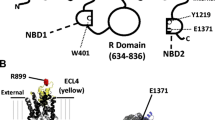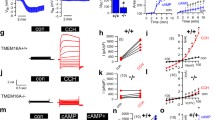Abstract
IN cystic fibrosis (CF), numerous epithelial cell functions are abnormal, including Cl− conductance, sodium absorption, mucin sulphation and enzyme secretion1–4. Although the CF gene product, the cystic fibrosis transmembrane conductance regulator (CFTR), functions as a small linear Cl− channel5–8, it is difficult to attribute such pleiotropic disease manifestations solely to a defect in Cl− conductance. This has led to speculation that CFTR regulates the activity of other proteins. One possible example is the protein kinase A activation of outward rectifying Cl− channels (ORCC), which is defective in membrane patches excised from CF cells9–16. Whether CFTR regulates the activity of an independent anion channel is debatable, because ORCC occur exclusively in excised membrane patches and could be an excision-induced molecular derivative of CFTR. 'Knockout' mice that lack CFTR17,18 provide a means to define the relationship between CFTR and ORCC. Here we report that ORCC are present in CFTR(−/−) mouse nasal epithelial cells and thus cannot be a derivative of the CFTR molecule. Also ORCC were regulated by protein kinase A in membrane patches from normal but not CFTR(−/−) cells. These observations are the first, to our knowledge definitive demonstration that CFTR regulates the activity of another protein.
Similar content being viewed by others
References
Knowles, M. R. et al. Science 221, 1067–1070 (1983).
Frizzell, R. A. Trends Neurosci. 10, 190–193 (1987).
Cheng, P-W., Boat, T. F., Cranfill, K., Yankaskas, J. R. & Boucher, R. C. J. clin. Invest 84, 68–72 (1989).
Quinton, P. M. FASEB J. 4, 2709–2717 (1990).
Kartner, N. et al. Cell 64, 681–691 (1991).
Anderson, M. P., Rich, D. P., Gregory, R. J., Smith, A. E. & Welsh, M. J. Science 251, 679–682 (1991).
Berger, H. B. et al. J. clin. Invest. 88, 1422–1431 (1991).
Bear, C. E. et al. Cell 68, 809–818 (1992).
Egan, M. et al. Nature 358, 581–584 (1992).
Frizzell, R. A., Rechkemmer, G. & Shoemaker, R. L. Science 233, 558–560 (1986).
Li, M. et al. Science 244, 1353–1356 (1989).
Chen, J. H., Schulman, H. & Gardner, P. Science 243, 657–660 (1989).
Schoumacher, R. A. et al. Nature 330, 752–754 (1987).
Hwang, T. C. et al. Science 244, 1351–1353 (1989).
de Jonge, H. R., van den Berghe, N., Tilly, B. C., Kansen, M. & Bijman, J. Biochem. Soc. Trans. 17, 816–818 (1989).
Jetten, A. M., Yankaskas, J. R., Stutts, M. J., Willumsen, N. J. & Boucher, R. C. Science 244, 1472–1475 (1989).
Snouwaert, J. et al. Science 257, 1083–1088 (1992).
Clarke, L. L. et al. Science 257, 1125–1128 (1992).
Ward, C. L., Krouse, M. E., Gruenert, D. C., Kopito, R. R. & Wine, J. J. Proc. natn. Acad. Sci. U.S.A. 88, 5277–5281 (1991).
Anderson, M. P., Sheppard, D. N., Berger, H. A. & Welsh, M. J. Am. J. Physiol. 263, L1–L14 (1992).
Tabcharani, J. A. & Hanrahan, J. W. Am. J. Physiol. 261, 992–999 (1991).
Tabcharani, J. A., Low, W., Elie, D. & Hanrahan, J. W. FEBS Lett. 270, 157–164 (1990).
Tabcharani, J. A., Chang, X. B., Riordan, J. R. & Hanrahan, J. W. Nature 352, 628–631 (1991).
Gabriel, S. E., Price, E. M., Boucher, R. C. & Stutts, M. L. Am. J. Physiol. 263, C708–C713 (1992).
Krauss, R. D. et al. EMBO J. 11, 875–883 (1992).
Morris, A. P., Cunningham, S. A., Benos, D. J. & Frizzell, R. A. J. biol. Chem. 267, 5575–5583 (1992).
Morris, A. P., Cunningham, S. A., Tousson, A., Benos, D. J. & Grizzell, R. A. Pediatr. Pulmonol. 8, suppl. 247 (1992).
Haws, C., Krouse, M. E., Xia, Y., Gruenert, D. C. & Wine, J. J. Pediatr. Pulmonol 8, suppl. 253 (1992).
Bradbury, N. A. et al. Science 256, 530–532 (1992).
Luckacs, G. L. et al. J. biol. Chem. 267, 14568–14572 (1992).
Fischer, H. et al. Pfluegers Arch. (in the press).
Stutts, M. J. et al. Proc. natn. Acad. Sci. U.S.A. 89, 1621–1625 (1992).
Author information
Authors and Affiliations
Rights and permissions
About this article
Cite this article
Gabriel, S., Clarke, L., Boucher, R. et al. CFTR and outward rectifying chloride channels are distinct proteins with a regulatory relationship. Nature 363, 263–266 (1993). https://doi.org/10.1038/363263a0
Received:
Accepted:
Issue Date:
DOI: https://doi.org/10.1038/363263a0
- Springer Nature Limited
This article is cited by
-
Impaired Regulatory Volume Decrease and Characterization of Underlying Volume-Activated Currents in Cystic Fibrosis Human Cholangiocyte Cell Line
The Journal of Membrane Biology (2022)
-
Innovative Therapies for Cystic Fibrosis: The Road from Treatment to Cure
Molecular Diagnosis & Therapy (2019)
-
Involvement of AMP-activated Protein Kinase (AMPK) in Regulation of Cell Membrane Potential in a Gastric Cancer Cell Line
Scientific Reports (2018)
-
Cystic fibrosis transmembrane conductance regulator—emerging regulator of cancer
Cellular and Molecular Life Sciences (2018)
-
CFTR supports cell death through ROS-dependent activation of TMEM16F (anoctamin 6)
Pflügers Archiv - European Journal of Physiology (2018)





